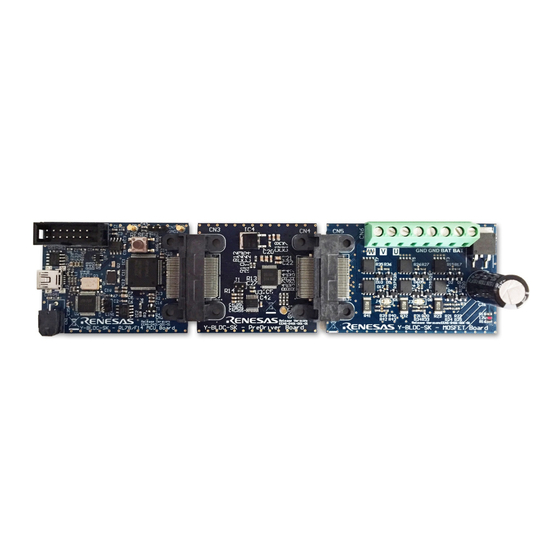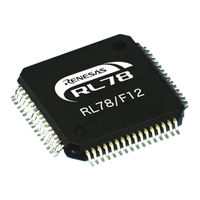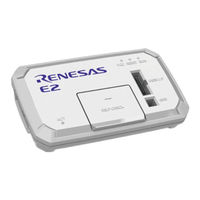
User Manuals: Renesas RL78/F14 Microcontrollers
Manuals and User Guides for Renesas RL78/F14 Microcontrollers. We have 5 Renesas RL78/F14 Microcontrollers manuals available for free PDF download: User Manual
Renesas RL78/F14 User Manual (1879 pages)
16-Bit Single-Chip Microcontrollers
Brand: Renesas
|
Category: Microcontrollers
|
Size: 21 MB
Table of Contents
-
-
-
P140 (Port 14)111
-
Reset113
-
Regc113
-
-
Memory Space120
-
Mirror Area150
-
SFR Addressing222
-
Based Addressing224
-
Stack Addressing229
-
-
-
-
X1 Oscillator427
-
XT1 Oscillator427
-
PLL Circuit431
-
Usage Notes455
-
-
-
I/O Pins576
-
Operation588
-
Timer Mode589
-
-
-
Registers601
-
Operation645
-
PWM Function665
-
PWM3 Mode676
-
Count Source682
-
-
-
-
-
-
Operation819
-
Noise Filter820
-
-
Master Reception876
-
Slave Reception906
-
Master Reception940
-
Slave Reception970
-
UART Reception1002
-
LIN Reception1017
-
Data Transmission1032
-
Data Reception1037
-
-
Pin Configuration1069
-
Start Conditions1072
-
Addresses1073
-
Acknowledge (ACK)1074
-
Stop Condition1075
-
Wait1076
-
Canceling Wait1078
-
Arbitration1081
-
Wakeup Function1083
-
Cautions1090
-
Timing Charts1119
-
-
Registers for UART1197
-
Modes1227
-
LIN Reset Mode1229
-
LIN Mode1230
-
UART Mode1232
-
LIN Mode1233
-
Status1248
-
Error Status1250
-
UART Mode1256
-
Status1274
-
Error Status1275
-
LIN Self-Test Mode1276
-
Baud Rate Generator1283
-
LIN Slave Mode1285
-
UART Mode1287
-
Noise Filter1288
-
Interrupts1290
-
-
Input/Output Pins1294
-
CAN Modes1412
-
Channel Modes1414
-
Reception Function1419
-
Timestamp1421
-
Test Function1427
-
Interrupt1429
-
RAM Window1433
-
Initial Settings1434
-
Clock Setting1436
-
Receive Rule Setting1439
-
Buffer Setting1440
-
Reception Procedure1442
-
Test Settings1454
-
-
Chapter 19 Dtc
1458-
Registers1460
-
DTC Vector Table1464
-
Operation1481
-
Normal Mode1483
-
Repeat Mode1485
-
Chain Transfers1489
-
Notes on DTC1492
-
DTC Response Time1496
-
-
Advertisement
Renesas RL78/F14 User Manual (59 pages)
Emulator
Brand: Renesas
|
Category: Computer Hardware
|
Size: 1 MB
Table of Contents
-
Overview7
-
RESET# Pin25
-
TOOL0 Pin28
-
Gnd29
-
VDD29
-
Reset46
-
Flash Memory46
-
Gdidis47
-
Go to Here]49
Renesas RL78/F14 User Manual (101 pages)
BLDC Starter Kit
Brand: Renesas
|
Category: Controller
|
Size: 5 MB
Table of Contents
Advertisement
Renesas RL78/F14 User Manual (58 pages)
E1/E20/E2 Emulator, E2 Emulator Lite
Brand: Renesas
|
Category: Computer Hardware
|
Size: 0 MB
Table of Contents
-
Overview7
-
RESET# Pin25
-
TOOL0 Pin28
-
Gnd29
-
VDD29
-
Reset46
-
Flash Memory46
-
Gdidis47
-
Go to Here]49
Renesas RL78/F14 User Manual (55 pages)
Brand: Renesas
|
Category: Computer Hardware
|
Size: 0 MB
Table of Contents
-
-
-
-
-
RESET# Pin25
-
TOOL0 Pin28
-
Gnd29
-
VDD29
-
-
-
Reset45
-
Flash Memory45
-
Gdidis46
-
-
Go to Here]48




